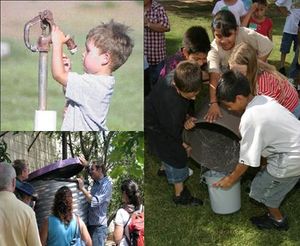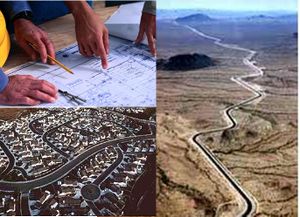Difference between revisions of "Stakeholder Page- Arizona"
(→Colorado River) |
(→Colorado River) |
||
| Line 20: | Line 20: | ||
• Central Arizona Project annually delivers an average of 1.5 maf Colorado River water. | • Central Arizona Project annually delivers an average of 1.5 maf Colorado River water. | ||
| − | The Arizona Water Banking Authority (AWBA) was established in 1996 to store the unused portion of Arizona’s annual allocation of the Colorado River water. By storing this unused water, the AWBA secures a dependable water supply. Each year, the AWBA pays the delivery and storage costs to bring Colorado River into Central and | + | The Arizona Water Banking Authority (AWBA) was established in 1996 to store the unused portion of Arizona’s annual allocation of the Colorado River water. By storing this unused water, the AWBA secures a dependable water supply. Each year, the AWBA pays the delivery and storage costs to bring Colorado River into Central and Southern Arizona through the CAP Canal. The water is stored underground in existing aquifers or is used by irrigation districts in lieu of pumping groundwater. For each acre-foot store, the AWBA accrues credit that can be redeemed in the future when Arizona’s communities, Indian tribes or neighboring states need this backup water supply. |
===Surface Water=== | ===Surface Water=== | ||
Revision as of 13:21, 1 May 2014
Arizona Department of Water Resources
With more than 125 years of experience in adapting to one of the most arid climates in the United States and due to our junior priority status on the Colorado River, Arizona has been proactively building resilience and implementing innovative water management strategies to secure dependable water supplies for our future.
Arizona’s population has grown steadily over the years, to more than 5 times and our economy has ballooned to more than 17 times that in 1955, however, through significant investments in conservation, reuse and infrastructure, our water use is essentially the same as it was more than half a century ago.
Arizona leads the nation in the implementation of water efficient reuse programs. More than 95% of treated wastewater generated within Central Arizona (including areas served by the Central Arizona Project and the Salt River Project) serve beneficial uses including agriculture, municipal, groundwater recharge, power generation, industrial, and turf irrigation.
These water supplies support ecologically vital wetland restoration that benefits our unique southwestern flora and fauna, as well as helping to achieve the State of Arizona’s water management goal of Safe-Yield for the Phoenix and Tucson Groundwater Basins.
Water Supplies
Arizona’s water supplies include water from the Colorado River (including Central Arizona Project Water); instate surface water, groundwater and reclaimed water or effluent. Water supply availability and use varies substantially throughout the State’s planning areas. While groundwater levels in wells may vary over time, groundwater is generally a reliable water supply in most parts of the state while in-state surface water supplies may fluctuate widely from year to year due to precipitation variability. Effluent reuse is increasing and although is represented just 3% of the total water supply in Arizona; it was an important supply in some planning areas.
Colorado River
• Arizona has an annual allotment of 2.8 maf of Colorado River water for consumptive use.• Of the state’s total Colorado River allotment, over 1.3 maf is available for use by municipal, industrial and agricultural users along the Colorado River in the Upper and Lower Colorado River planning areas.
• Central Arizona Project annually delivers an average of 1.5 maf Colorado River water.
The Arizona Water Banking Authority (AWBA) was established in 1996 to store the unused portion of Arizona’s annual allocation of the Colorado River water. By storing this unused water, the AWBA secures a dependable water supply. Each year, the AWBA pays the delivery and storage costs to bring Colorado River into Central and Southern Arizona through the CAP Canal. The water is stored underground in existing aquifers or is used by irrigation districts in lieu of pumping groundwater. For each acre-foot store, the AWBA accrues credit that can be redeemed in the future when Arizona’s communities, Indian tribes or neighboring states need this backup water supply.
Surface Water
Arizona surface water supplies derive chiefly from snow along the Mogollon Rim and high elevation mountains of east central Arizona and western New Mexico. The Salt, Verde and Gila rivers are essential supplies for water users in central Arizona. The Salt River Project (SRP), through the Salt River Valley Water Users’ Association, annually delivers a total of almost 1 maf of surface water from the Salt and Verde rivers and groundwater to its service area in the Phoenix AMA.
SRP manages several dams on the Salt and Verde rivers that produce hydroelectricity and has substantial surface water right claims in the Salt and Verde watersheds. Water supplies utilized by the towns of Cottonwood, Clarkdale, Camp Verde, Payson and others are derived from the watersheds of the Salt and Verde rivers. The water supplies of the upper Gila River communities of Safford, Thatcher and others are impacted by senior surface water right holders downstream of their communities; the Globe-Equity Decree and by Indian water rights settlements.
Groundwater
With the exception of the Lower Colorado River and AMA planning areas, groundwater is the primary water supply utilized for cultural uses, accounting for approximately 43% of the state’s total water supply annually during 2001-2005. While a number of hydrologic studies and groundwater models have been completed in the AMA’s, there is often less known about the groundwater conditions outside AMA’s where fewer comprehensive studies have been done.
The Department conducts water level and water quality measurements periodically statewide and maintains a repository for statewide groundwater well data. The database includes well log data and historic groundwater level records.
As drought and growth stress the availability of surface water supplies, communities that historically have relied on surface water are exploring groundwater resource options including drilling additional wells and acquiring land for wellfield development.
Reclaimed Water
Access to renewable water supplies, especially outside of the AMA’s, may be physically or legally limited. An exception is reclaimed water or effluent, which increases with population growth served by a sewer system. Effluent has met up to 8% of the municipal demand and 27% of the agricultural demand in the Eastern Plateau Planning Area and 28% of the Industrial demand in the AMA planning area. While the percentage of reporting treatment facilities is low in some planning areas, data are available for the largest facilities. Of the 53% of total facilities for which treatment volumes and reuse data are available, 53% of that effluent has been reused primarily for turf irrigation, groundwater recharge, agricultural irrigation and for cooling purposes at the Palo Verde Nuclear Generating Station in the Phoenix AMA.
The highest percentage of reuse is in the Prescott AMA where 91% of the treated effluent is either recharged or used directly for golf course irrigation. A constraint on more reuse is that potential users, such as parks and golf courses, are often distant from treatment facilities and communities lack financing to construct the necessary delivery infrastructure.
Conservation
To help Arizonans learn how to reduce water use, Arizona Department of Water Resources offers an assembly of tools to assist residents, businesses, communities and water providers in the design and implementation of comprehensive and proven conservation strategies.
Technologies
The rapid development of technologies both new and improved will help all water users be more efficient. This section describes current and new technologies that can reduce water and energy consumption and associated costs. However, even the best technology becomes inefficient without implementation of proper operation and maintenance practices. For tips on how to improve water-use behavior, please see Water Conservation Tips for Arizona Residents. For information about facility water-use efficiency, developing facility water management plans and audits.
Water Planners and Providers
Some water providers in the state are required to conserve but all water providers are encouraged to conserve.
- Conservation Tools for Water Planners and Providers
- Conservation Planning Information
- Programs, Resources and Organizations
Residential
Residential water use includes water used indoors (bathing, cooking, cleaning, etc.) and water used outdoors (watering plants, swimming pools, washing cars, etc.) In Arizona, about 25% of the water supply is for municipal use, and most of this is residential. Each person uses about 100 gallons per day, and as much as 70% of that water is used outdoors, especially in summer. Residents that incorporate water efficiency into everyday life will help to preserve water for future generations.
The following information is designed to help Arizona residents use water wisely and efficiently indoors and out.
Commercial, Industrial & Institutional
In Arizona, approximately 15% of the water supply is for commercial, industrial and institutional uses. This includes water used by commercial buildings, hospitals, schools, golf courses, parks, power plants, and other industries. Some of these entities receive municipal water supplies, while others have rights to wells and pump their own water. Arizona businesses, industries and institutions are encouraged to conserve the water they use, whether or not they are regulated by state law.
- Summary of ADWR Conservation Requirements for Industrial Water Users
- Conservation Tools for Commercial, Industrial and Institutional Facilities
- Programs, Resources and Organizations
Agriculture
Irrigated agriculture is the largest use of water in Arizona, using about 68% of the available water supply. In the past, this percentage was as high as 90%; reductions have been the result of both urbanization of agricultural lands and heavy investment by the irrigated agriculture industry in conservation measures both on-farm and in delivery systems.
These investments and practices help growers stretch water supplies, increase productivity and profits, manage situations of water supply scarcity, reduce energy costs and meet the conservation requirements of Arizona's 1980 Groundwater Code.
The links below provide water-efficiency information and assistance for Arizona farmers and ranchers.
- Best Management Practices
- Computer-Based Tools
- Educational Information
- Programs, Resources and Organizations
Landscape Professionals

- Training and Certification
- Plant Lists and Landscaping
- Irrigation and Water Harvesting
- Programs, Resources and Organizations
Water Conservation Education and Outreach
The Arizona Department of Water Resources believes in lifelong learning and is committed to promoting responsible water stewardship through education. ADWR supports partnerships, sponsors educator workshops, and participates in educational events in an effort to bring quality water education programs to Arizona.
The links below provide water education information that will assist students, educators and other adults in learning about water in Arizona and discovering why it is so important to protect this crucial resource.
- Activities and Resources for Students
- Resources and Workshops for Educators
- Water Education for Adults


